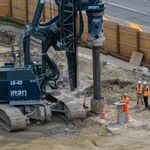Precisely....we have to be very careful about which stats/measures we use. And, yes, you have nailed my concern bang on....even if we could get to 400 ppl/train (and that is a stretch) coming out of KW.....have we done the right thing if we then have those underused trains zoom through other stations where potential riders are? In other words...if increasing ridership to those levels requires a 1.5 hour trip....and a 1.5 hour trip requires bypassing busy stations....is the increased ridership worth it (justified) when you consider the riders left behind and the capacity utilization.
You are bang on about average riders per train. The lakeshore line saw a very big (50%) increase in off peak ridership within a year of the 30 minute frequency ...but it required an even bigger increase in capacity to get there (100%) so the cost of that 50% increase in riders was a reduction in the average number of people per train and an increase in the annual cost/subsidy (+/- $7mil a year comes to mind but I am too lazy to look it up so it may have been more or less than that).
It is indeed a very interesting discussion that admittedly neither of us has enough information to make a solid determination on.
But for the sake of discussion here's a quick back of the envelope calculation for a single trainset. As I write this sentence I haven't done it yet and have no idea how it will turn out - this will be just as revelational for me as for you.
Under the current fare system, the ticket price from K-W to Union is $14.94 and from the Brampton to Union is $8.73 to $7.20 (let's say $8). So each KW-Union rider brings in about 1.9 times as much revenue as a Brampton-Union rider.
If we take a really simplistic impression of our current ridership per train as around 200 people from KW and 1800 people from Brampton, we're looking at around $17,400 in revenue.
Cutting the travel time from 2h06 to 1h36 is a 24% reduction, which based on a fixed rate of operating cost I'll assume to correspond to a reduction of 24% in operating cost. So to retain the same cost recovery ratio for the train, we need 24% less revenue - $13,200 in our scenario.
If we work with our "double the K-W ridership per train" scenario (i.e. still two trains per day, but 30 min faster) we'd have a revenue of $6000 from Kitchener, leaving $7200 to be accounted for by Brampton riders, which works out to 900 passengers - only half the ridership in the "current" scenario.
So the question is, would the express service lose more half the ridership from Brampton in the process of doubling the ridership from Kitchener? I don't know.
This simplistic calculation doesn't account for riders from other stations (that would be making way too many assumptions to be any more accurate), or account for any economic benefits/costs.
I feel like the both of express stopping patterns I proposed would do just as well as the current service based on cost recovery - the lost ridership from Mount Pleasant, Malton and Etobicoke being fully offset by increased revenue from Kitchener, Guelph, Georgetown, Brampton and Bramalea.
you are correct that it is difficult to base much on the current ridership levels as it is based on two trains. But they were fairly careful in picking which two trains they extended to/from KW to ensure they were ones that got people to Union in time for the typical work day....so they are likely to represent the most popular time slots (ie. if we can only do 2 which are the best) so adding in two more is not likely to double the riders).
Speaking of arrival times, the more we increase the speed of the train, the more practical it becomes for other commutes along the line. For example, the current eastbound trains arrive at Guelph at 6:08 and 7:26, and depart westbound at 18:20 and 19:23. Given that Greyhound service is terrible, it is pretty much impossible to use the train for commuting from Kitchener to Guelph - a demand that is supposedly so large that they need an additional highway to serve it.
Assuming that the times at Union stay the same, cutting the travel time would make the morning arrivals later and afternoon departures earlier, bringing KW-Guelph commuting more into the realm of possibility. I have no statistics to back me up, but my impression is that the number of people commuting from KW to Guelph exceeds the number of people commuting from KW to Toronto.
It's a nice thought but the reality is that the area highways are being expanded anyway....and to get to your 8% capacity of a freeway lane you have now jumped the usage to 200 per hour......I think we are now in the "really massively massive" increase in GO train usage area

This increase is the same magnitude that you and I have both been talking about. There is currently 1 train per hour in the peak direction. Ergo, 200 people per hour is 200 people per train. If we double service to 2 trains per hour, then that's a mere 100 people per train, which I'd go as far as to classify as "really quite reasonable".
I have no doubt that Kitchener is growing....but its growth pales in comparison to some GTA communities.....some of which are the ones you would be bypassing with those express trains.
Again, we have enough track capacity to run as many trains as we like on the central segment of the line. Adding some express trains to Kitchener does not take anything away from those communities.
As far as I can tell...that "doubling service to Kitchener by 2016" plan is simply extending two more of the existing trains to KW....I have seen nothing in that plan (not the ReR plan but the short term promise of two more trains to KW) that suggests they will be anything other than further extension of 2 existing trains. Since only one of the non-extended trains has any express feature to them, I guess one of those would be a bit faster if that one is one of the ones extended (and if you read way back, I have questioned in the past why that was not one of the first two extended)...but the 4th one at least, like the existing 2, would have to continue to be all stops.
The fact that they are replacing the current two-trainset Kitchener Yard with a new 4-trainset yard suggests that they intended to at least add two trainsets to the line. Given the rhetoric about expanding service and the fact that we just spent a billion dollars expanding the railway, they'd have an awfully hard time explaining two empty storage spots along the line. Furthermore, with double tracks returning to the Weston Sub, we can provide more frequent service by emptying out Georgetown Yard more quickly in the morning and having the later trains arriving counter-peak from Union.




